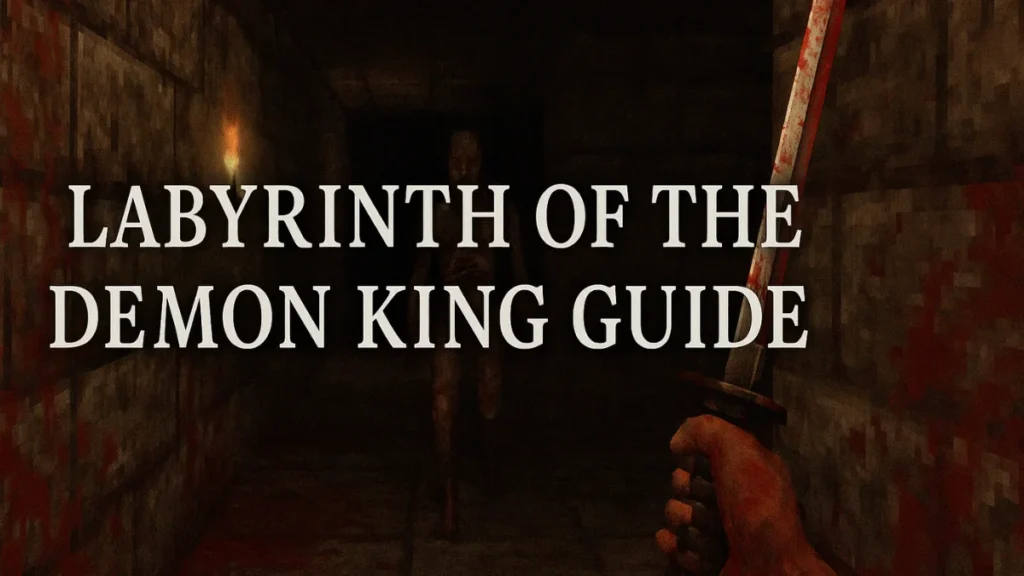Labyrinth of the Demon King is a first-person survival horror dungeon crawler that blends the oppressive atmosphere of Silent Hill with the methodical combat of King’s Field. Designed as a love letter to PS1-era horror RPGs, it challenges players with stamina-based combat, cryptic puzzles, and a labyrinthine world filled with grotesque enemies.

This guide covers essential mechanics, weapon upgrades, exploration strategies, and advanced tips to help you navigate its horrors efficiently.
Core Combat Mechanics
Combat in Labyrinth of the Demon King is intentionally slow and nerve-wracking. Players must master precise timing, stamina management, and effective spacing to stand a chance against the yokai that stalk the labyrinth.
- Kicking: A melee mechanic that staggers enemies, breaks guards, and creates safe openings. It’s essential for setting up attacks or interrupting foes.
- Dodging: Comes with a cooldown penalty if repeated too quickly. Master single dodges and positioning rather than panic-rolling.
- Parrying: High risk, high reward. Only viable against slow, telegraphed strikes—use it sparingly.
- Stamina Management: Upgrade this stat before health. Efficient movement and sustained offense depend on stamina.
Once these basics click, combat becomes less of a burden and more of a tense, rewarding dance.
Weapon System and the Broken Katana
A major strategic moment arrives when you’re given a one-time chance to repair your broken katana. This decision is permanent, and the sword you use in the fusion determines the final stats and appearance of your Chrysanthemum Blade.
Here’s what each fusion option offers:
- Rusty Katana: An early-game sword. Results in the weakest version of the final blade. Avoid.
- Royal Katana: Purchased from the shop. Produces a balanced weapon with solid base damage.
- Prison Katana (Bloodletter): A cursed sword with bleed effects. Dev J.R. Hudepohl recommends this as the most satisfying outcome.
Tip: Wait until mid-game before repairing. The Prison Katana is hidden deep, but rewards patience with unique aesthetics and mechanics.
Mid to Late Game Weapon Options
As you progress, other weapon types open up, offering variety in speed, reach, and stamina cost. This section matters because adapting your weapon to enemy type can dramatically ease your experience.
- Great Dao: A heavy sword with sweeping arcs. Great for dealing with groups but drains stamina fast.
- Naginata/Spears: Long reach weapons ideal for poking enemies safely.
- Otsuchi (Hammer): Blunt weapon perfect for breaking armored foes.
- Rifle: Long-range option with limited ammo. Ideal for picking off dangerous targets at a distance.
Experiment with these to find a loadout that complements your playstyle and stamina pool.
Exploration and Puzzle Navigation
Exploring the labyrinth is more than finding loot—it’s about learning the game’s logic and environment. This section outlines how to use exploration to your advantage.
- Save Shrines: Function like bonfires. Use them to anchor progress but note that they’re sparse.
- Environmental Clues: Many puzzles reference scrolls, carvings, or item placements. Read everything.
- Notable Puzzles:
- King’s Court Puzzle: Requires item placement on thrones based on historical hints.
- Butsudan Restoration: Involves locating a lost statue deep in the prison wing.
- Backtracking Required: New items open old areas—revisit zones often.
Enemy Behavior and Survival Tips
Monsters in Labyrinth of the Demon King are designed to unsettle. Their erratic behaviors, grotesque designs, and ambush patterns demand adaptive play.
- Nuribotoke: A stalker enemy who randomly appears and pursues you. Hide in cupboards or flee; direct confrontation is rarely wise.
- Ambush Triggers: Some enemies spawn after you enter rooms. Always check corners.
- Status Effects: Use talismans to cleanse, block, or inflict debuffs. Don’t hoard them—they’re survival tools.
- Weapon Matchups: Blunt weapons work better against armored enemies. Adjust your loadout accordingly.
Game Atmosphere and Visual Design
Atmosphere is as much an opponent as the monsters. Understanding how the game uses visual and audio cues will help you brace for upcoming horror.
- Visual Filters: The game employs strong dither filters and grain. You cannot turn these off, but they serve to disorient.
- Audio Design: Inspired by Silent Hill, featuring creaks, moans, and static. Use audio to sense nearby threats.
- Claustrophobic Mapping: Every corridor feels lived-in and oppressive. Get used to tight turns and limited sightlines.
These artistic choices reinforce the fear—not just of enemies, but of the environment itself.
Advanced Tips and Replay Value
Once you’ve survived the first run, deeper systems reveal themselves. Here’s how to go further:
- Merchant Cat: Listen for a faint jingling sound. This NPC sells rare consumables and upgrade items.
- Skip Cutscenes: Available via ESC or equivalent—ideal for speedrunners.
- Replay with a New Fusion: Try a different sword with your katana hilt to unlock alternate Chrysanthemum Blades.
- Final Tower Prep: Focus on upgrading one strong weapon and stack healing items.
Patience, observation, and experimentation are key in Labyrinth of the Demon King. From its slow-burn combat to its chilling corridors, the game demands that you engage deeply or perish quickly. Whether you’re exploring its grotesque secrets for the first time or planning a second playthrough with a new weapon path, the labyrinth always has more to show those willing to look.
Read More:
How to Fix Star Citizen Lobby Error 60009 (Matchmaking Disabled Issue)
Cookie Run Kingdom Boss Rush Guide: Meta Teams, Hidden Synergies & How to Beat All Stages

